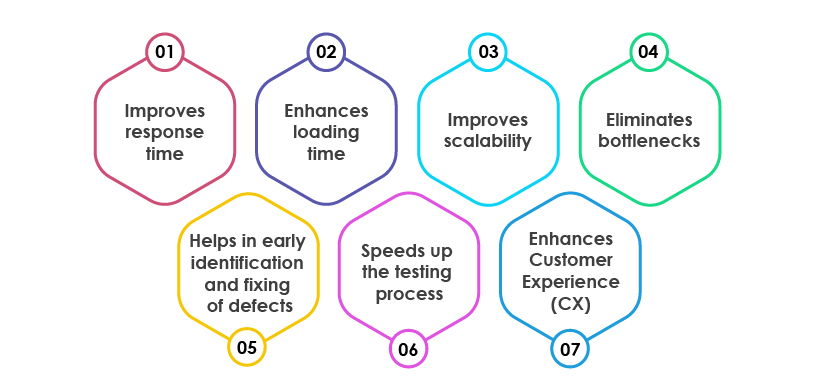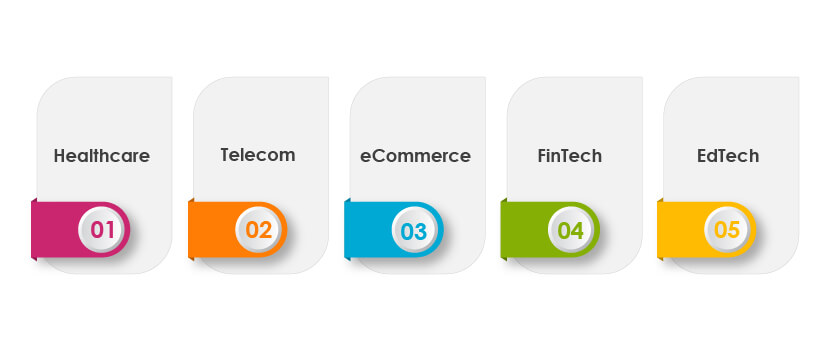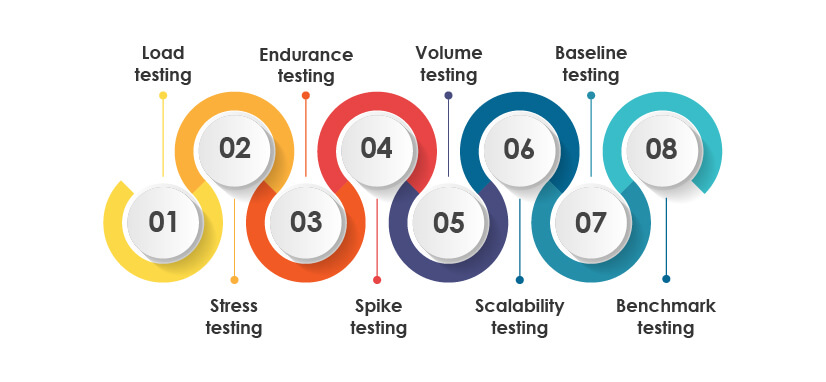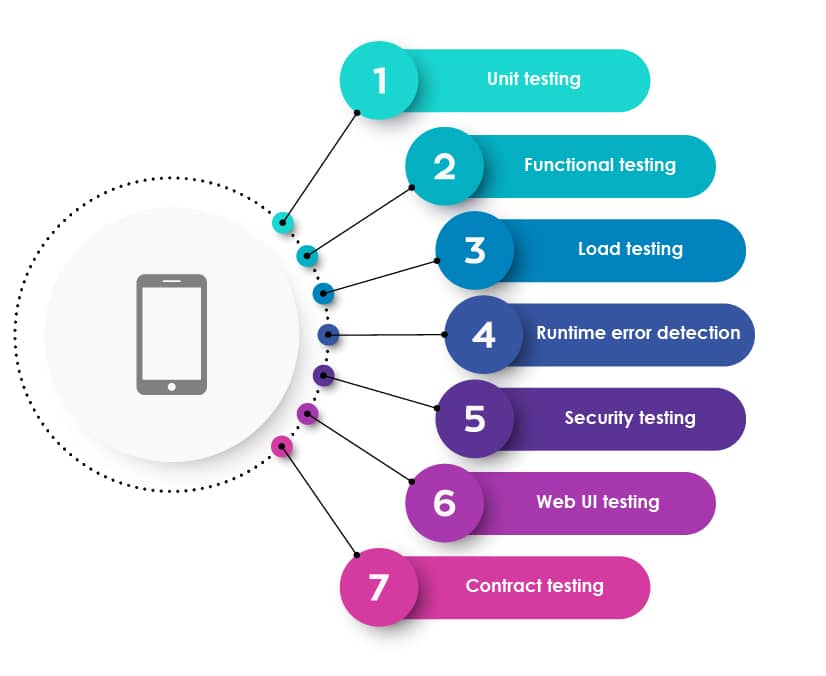Recommended Blogs
Role of Performance Testing for Businesses Across Industries

Table of Content:
- What is the importance of application performance for businesses
- Performance Testing Overview
- Benefits for Businesses Leveraging Performance Testing
- Why is Performance Testing Required?
- Need for high-performing apps across some major industries
- Different Performance Testing Types Businesses should leverage
- Conclusion
- How can TestingXperts (Tx) help?
What is the importance of application performance for businesses?
With the rapidly changing customer expectations across the business landscape, the need for high-performing apps is growing in the market. Today, every business needs apps that perform seamlessly to attract new customers and retain existing users. Also, today’s customers expect companies to deliver apps that load fast and perform seamlessly even under peak loads to provide a great Customer Experience (CX).
Typically, businesses need apps that perform flawlessly under various conditions such as fluctuating networks, low bandwidths, high user loads, etc. For example, If a mobile application performance does not meet the user expectations, users are likely to abandon that app and switch to the nearest competitor. Invariably, the application or website or the web app performance plays a significant role. Therefore, to ensure that the apps perform seamlessly under all conditions, businesses must deliver a seamless user experience.
Performance Testing Overview
Performance testing is a non-functional software testing method that validates the app’s speed, responsiveness, scalability, and reliability. This load testing method checks if the application performs seamlessly under varying networks, bandwidths, and under varying user loads. Some of the app issues identified with this type of testing are runtime error, optimization issues related to speed, latency, throughput, response times, load balancing, etc.
Why is Performance Testing Required?
Latest research analysts views on the need for high-performing apps
According to Statista, there are almost 3.5 million apps available on the Google Play Store and nearly 2.2 million apps available for iOS as of the second quarter of 2022. The report also states that only the best-performing apps stand out in the market and will attract customers.
Think with Google, a one-stop shop of Google for understanding industry trends, in one of its blogs on ‘Speed is key: Optimize your Mobile Experience,’ states that 29% of smartphone users will immediately switch to another site or app if the app is slow or doesn’t satisfy their needs.
According to a Pinterest Engineering Blog titled ‘Driving User Growth with Performance Improvements,’ it has been stated that Pinterest engineers ran an experiment in which they rebuilt web pages for performance. As a result, it led to a 40 percent decrease in Pinner wait time, a 15 per cent increase in SEO traffic, and a 15 per cent increase in conversion rate to new signups.
The above statistics showcase how critical the performance of mobile & web app or website is for businesses. Let us further understand the significance and the need of application performance across some major industries.
Benefits for Businesses Leveraging Performance Testing

1. Improves response time:
Response time is the total time taken by the software to generate an output against the input received. Typically, this testing method helps to improve the app’s response time by removing performance-related issues from the software.
2. Enhances the load time:
It is known that slow-loading websites annoy customers, and similar is the case with mobile apps having more load time, users either abandon the app or move to the nearest competitor. Typically, this testing method improves the loading time of applications by identifying and removing performance and load-related issues or bugs from the software.
3. Improves scalability:
The scalability of an app refers to its capacity to handle varying user loads seamlessly. This test helps in enhancing the load handling capacity of apps by testing the apps and websites under varying user loads.
4. Eliminates bottlenecks:
Bottlenecks are the barriers that decrease the responsiveness of the entire system. This performance testing method helps to find performance bottlenecks in the software by identifying the areas that cause the problems and helps to fix them by notifying the dev team promptly.
5. Helps in early identification and fixing of defects:
Performance testing allows testers to detect and fix performance-related issues faster and frequently. It enables testers to quickly identify issues and helps in faster resolution of bugs.
6. Speeds up the testing process:
In the earlier software development models like the waterfall model, the testers had to wait for the development process to get over to start the software testing. But in an agile environment, performance testing is integrated along with the development process, which speeds up the overall software testing process. Typically, a shift-left method of testing is followed in parallel to development which ensures faster results.
7. Enhances Customer Experience (CX):
Performance testing ensures delivery of high-quality products to customers in less time. Faster delivery of quality products enhances CX and makes the stakeholders and customers happy.
Need for high-performing apps across some major industries

Enterprises across industries require their websites, web apps & mobile apps to perform seamlessly 24×7, and each of the industry segments, as given below, states the significance for app performance.
Healthcare:
• Healthcare apps bridge the gap between healthcare service providers, doctors, patients, and third-party service providers.
• Healthcare apps help patients book appointments with doctors, get real-time consultation with physicians, view and maintain health records, purchase medicines via telepharmacy apps, telemedicine apps, etc.
• According to Grand View Research, the global mHealth apps market size was valued at USD 40.05 billion in 2020 and is expected to grow at a CAGR of 17.7% from 2021 to 2028. The major forces driving the growth of mHealth applications in the healthcare sector are better treatment outcomes and improved patient lifestyles enabled by these apps.
• Invariably, It is essential to ensure that the healthcare apps should perform seamlessly under all network conditions and workloads to deliver a great CX to its users.
Telecom:
• Telecom apps enable the flow of communication and information sharing via various platforms such as telephony, video conferencing, broadcasting, television media, instant messaging, e-mails, etc.
• Various types of telecom apps such as retailer apps, mobile wallets, CRM apps, customer support apps, etc., help businesses and customers to interact, share information, perform transactions, etc., with just a click of the button.
• According to Grand View Research, the global telecom services market size was valued at USD 1,657.7 billion in 2020 and is expected to expand at a CAGR of 5.4% from 2021 to 2028.
• Telecom companies must ensure their apps load fast, perform seamlessly under varying user loads and fluctuating network conditions to deliver a great CX and protect brand image.
eCommerce:
• Today, eCommerce apps continue to dominate the retail and shopping sector as it allows end-users to view and shop products on the go.
• eCommerce apps allow users to perform various tasks such as viewing products, adding products to cart/wish list, removing products from cart/wish list, paying the amount via EMI, Wallet, UPI, COD, etc.
• According to Statista the eCommerce software application market had an estimated value of around 5.1 U.S. dollars in 2018 and is forecasted to grow to approximately 6.3 billion U.S. dollars by 2023 during the forecast period of 2019-2024.
• eCommerce app providers should ensure that their apps perform seamlessly during peak days holiday sales like Cyber Monday, Black Friday, etc. These business-critical apps should perform as expected under all networks and user loads to deliver a great shopping experience to customers.
BFSI/FinTech:
• Banking and finance apps have become a part of human lives, as these apps allow users to perform transactions with a single click.
• Banking apps have made customer’s lives easy as users can now pay bills, transfer money, book tickets, buy policies, etc., on the go.
• According to Mordor Intelligence, the financial services application market was valued at USD 103.99 billion in 2019 and is expected to reach USD 164.01 billion by 2025, at a CAGR of 7.89% over the forecast period 2020–2025.
• Banking apps should deliver expected performance under peak hours to eliminate chances of a server crash, app crash, stuck payments, etc. High-performing banking apps help businesses to deliver a seamless online banking experience to customers.
EdTech:
• EdTech apps have gained a lot of importance, especially amid the COVID-19 pandemic. EdTech apps help teachers, students, and others to connect online.
• EdTech apps help teachers provide virtual education to students and allow students to attend online classes, watch videos, and write exams virtually.
• According to MarketsandMarkets, the global EdTech and smart classroom market size is expected to grow from USD 85.8 billion in 2020 to USD 181.3 billion by 2025, at a CAGR of 16.1% during the forecast period of 2020-2025.
• The EdTech apps should perform seamlessly 24/7 under all conditions to ensure great learning and teaching experience for both students and teachers.
Across industries, businesses need scalable, robust, and high-performing apps to deliver a great CX. Hence, businesses should leverage different performance testing types to get seamless apps.
Different Performance Testing Types Businesses should leverage

1. Load testing:
This testing method evaluates the potential of an application to work under varying user loads. It is conducted to remove any performance bottlenecks from the system.
2. Stress testing:
It identifies the breaking point of the software when it is subjected to a user load beyond the expected peak. This testing method verifies the stability & reliability of software applications and measures their robustness and error handling capabilities under extremely heavy load conditions. It also ensures software does not crash under varying conditions.
3. Endurance testing:
It checks the system’s performance when it is under significant load (around 70% of peak load) for a longer period (usually 8 hours to 72 hours). This testing method helps in improving the performance, stability, and reliability of the app.
4. Spike testing:
It is a subset of stress testing and checks the performance of the software by suddenly varying the no. of users. This testing method also checks if the software can handle fluctuating user loads under varying conditions.
5. Volume testing:
In this testing, the data load of the software is increased, and its performance is then checked. It helps in providing the volume of data that can be handled by particular software.
6. Scalability testing:
This test identifies the actual number of users that the system can support with existing hardware capacity.
7. Baseline testing:
Each time the software application is updated, performance testing is performed, and baseline metrics of the software application are recorded. These baseline metrics are compared with the results of previously recorded performance metrics. This testing method helps businesses to ensure that a consistent quality of the software is maintained.
8. Benchmark testing:
This testing method compares performance testing results against performance metrics based on different industry standards. This software testing method helps businesses ensure that the software’s current and future releases meet high-quality standards.
Conclusion
With the growing business competition and intricate application architecture, the need for high-quality and optimally performing apps is rising in the market. Though millions of apps are available, only the high-performing apps attract the customer and survive the competition. It is a known truth that low-performing apps affect the brand’s reputation and customer experience. Therefore, businesses should leverage performance testing to ensure their critical apps are of high quality and perform seamlessly to deliver a great CX.
How can TestingXperts (Tx) help?

TestingXperts (Tx) helps businesses predict application behaviour and benchmark application performance. Tx ensures the application is responsive, reliable, robust, scalable, and also meets all contractual obligations and SLAs for performance. Tx offers performance and load testing services across domains and technologies, including web-based n-tier applications, client-server applications, SOA-based solutions, or COTS solutions.
We have rich experience in all industry-leading performance testing and monitoring tools, along with expertise in end-to-end application performance testing, including network, database, hardware, etc. We publish a detailed performance testing report for the application with response times, break-point, peak load, memory leaks, resource utilization, uptime, etc. Get in touch with our performance testing experts to know more.
Discover more
